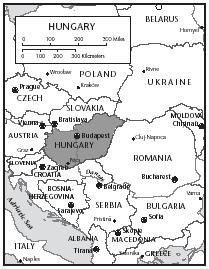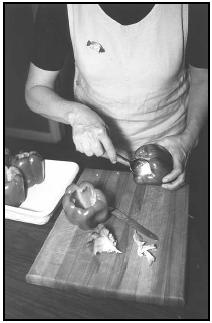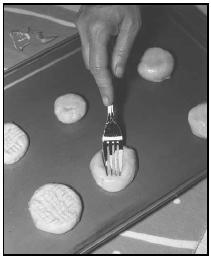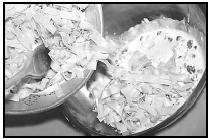Hungary
Recipes

1 GEOGRAPHIC SETTING AND ENVIRONMENT
Hungary is a landlocked country in the middle of Europe. It is a little smaller than Indiana, and is a land with fertile soil. Hungarian farmers grow enough wheat, corn, rye, potatoes, and some fruits, to feed its population. Even though many Hungarian farmers raise livestock, the quality of the animals they raise (and the meat they produce) is below the standard of Hungary's neighbors, mostly because there is not enough quality animal food available.
One of the largest challenges facing Hungary is the preservation of its environment. Hungary has huge problems with air and water pollution, but the government does not have enough money or technology to minimize pollution from factories.
Hungary's principal rivers are the Danube and Tisza, and the largest lake is Balaton. All three provide good fishing areas for Hungary's sport and commercial fishers.
2 HISTORY AND FOOD
The first people to live in present-day Hungary were nomads called the Magyars, who arrived in around A.D. 800. Hungary's national dish, a meat stew called goulash, can be traced to the Magyars' eating habits. They traveled with dried cubes of meat cooked with onions, and water could be added to make a stew.
The reign of King Matthias (1458–90) was a high point in Hungarian history, for both culture and food. Through his Italian wife, Queen Beatrice, King Matthias brought Italian cooking to Hungary. During this period, cooking was raised to a fine art.
When the Turks invaded Hungary in the sixteenth century, they brought their cooking customs with them. These included the use of the spice paprika and a thin, flaky pastry called filo (or phyllo ) dough. They also taught the Hungarians how to cook stuffed peppers and eggplants. The Turks introduced coffee to Hungary.
Austria's Hapsburg monarchy gained control over Hungary from the seventeenth century to the beginning of the twentieth century. Under Austrian rule, German and Austrian cooking styles influenced Hungarian eating habits. During this period, Hungary became famous for its cakes and pastries.
3 FOODS OF THE HUNGARIANS
The best-known ingredient in Hungarian food is the red-powdered spice called paprika. It is used to flavor many dishes. Other staples of Hungarian cooking include onions, cabbage, potatoes, noodles, and caraway seeds. Both cream and sour cream are used heavily in Hungarian food. Dumplings (dough wrapped around different kinds of fillings) are very popular as are cabbages or green peppers stuffed with meat and rice. Another favorite is the pancake called a palacsinta. It is often rolled or wrapped around different kinds of fillings.
Hungarians eat a lot of meat, mostly pork or beef. Many meat dishes are dipped in bread and then baked or fried. Hungarians also prepare many different kinds of sausages. The Hungarian national dish is meat stew. People outside Hungary call it "goulash," but the Hungarians have several different names for it, including pörkölt and tokány . The dish they call goulash, or gulyás, is actually a soup made with meat

The Hungarians are known throughout the world for their elegant pastries and cakes. The flaky pastry dough called filo or phyllo was brought to Hungary by the Turks in the seventeenth century. Instead of the honey and nuts used in Turkish pastry, the Hungarians filled phyllo dough with their own ingredients to make a dessert known as strudel. Strudel fillings include apples, cherries, and poppy seeds. Hungary is known for its wines, especially the sweet wines of the Tokay region.
Pörkölt (National Hungarian Stew)
Ingredients
- 2 Tablespoons olive oil
- 2 Tablespoons butter
- 3 onions, finely chopped
- 1 pound lean beef stew meat
- 4 potatoes, peeled and sliced thin
- 1 cup beef broth
- 1 small can tomato paste
- Salt and pepper, to taste (½ teaspoon each is suggested)
- 2 to 4 Tablespoons paprika
- 1 bay leaf
- 1 cup sour cream
Procedure
- Heat olive oil and butter in a large pot.
- Add onions and beef, and cook until beef is browned on all sides and onions are softened.
- Add remaining ingredients, except sour cream, and stir gently with a wooden spoon.
- Heat until liquid begins to bubble.
- Reduce heat to low, cover, and simmer stew 1½ to 2 hours.
- Stir in sour cream and simmer about 15 more minutes.
- Serve with crusty bread.
Serves 6.
Gulyás (Hungarian Goulash)
Ingredients
- 2 Tablespoons vegetable oil
- 1½ pounds beef (round steak or boneless chuck), cut into 1-inch cubes
- 2 onions, coarsely chopped
- 3 cloves garlic, chopped, or 1 teaspoon dried garlic
- 2 cups water
- 2 cups beef broth, homemade or canned
- 1 cup canned stewed tomatoes
- 2 teaspoons Hungarian paprika
- 2 bay leaves
- 2 potatoes, cut into 1-inch cubes
- 2 carrots, cut into ½-inch slices
- 2 green peppers, cut into 1-inch pieces
- Salt and pepper, to taste
- Caraway seeds
Procedure
- Heat oil in skillet or Dutch oven over medium heat, add beef, and cook, stirring continually, until brown (about 5 minutes).
- Reduce heat to medium, add onions and garlic, and cook for 5 minutes more until onions are soft. Stir frequently.
- Add water, beef broth, tomatoes, paprika, caraway seeds, and bay leaves, reduce to simmer, cover, and cook for 1 hour.
- Add potatoes, carrots, green peppers, and salt and pepper to taste. Mix well, cover, and simmer for about 20 minutes more or until vegetables are tender.
- Before serving, remove bay leaves and discard.
- Serve in individual bowls with chunks of crusty bread for dunking. Both a fork and spoon are needed to eat gulyás.
Serves 6 to 8.
Paprika Chicken
Ingredients
- 1 large onion, sliced in rings
- 4 Tablespoons butter
- 1½ Tablespoons Hungarian paprika
- 1½ pound chicken, washed, cut up and salted
- 1 green pepper, sliced
- 1 tomato, sliced
- ¼ pound mushrooms (optional)
- ½ cup sour cream (optional)
Procedure
- Sauté onion rings in butter in a medium pot or a Dutch oven until you can see through them.
- Remove from heat and add paprika, chicken, half of the green pepper and half of the tomato.
- Cover tightly with a lid and simmer slowly for 1½ hours.
- Occasionally turn pieces over so they will cook evenly.
- If necessary, add small amounts of water.
- If mushrooms are used, add during last 15 minutes of cooking time.
- When meat is tender, transfer to a baking dish.
- Make pan gravy, scraping onion from the pan and adding a little water.
- Pour over chicken.
- Garnish with remaining green pepper and tomato.
- Cover with foil and keep warm in the oven at a low temperature until ready to serve.
- Sour cream can be added to the gravy.
Serves 4.
Stuffed Green Peppers
Ingredients
- 3 Tablespoons rice
- 6 green peppers
- 1 medium-sized onion, finely-chopped
- 2 Tablespoons butter, melted
- 1 pound ground meat
- 1 egg
- Salt and pepper, to taste
- 2½ cups tomato sauce
Procedure
- Simmer rice in 5 Tablespoons water for 10 minutes.
- Cut off the top of the peppers at the stem and scoop out the seeds.
- Sauté onion in butter until transparent.
- Remove from pan and mix with meat, rice, egg, salt, and pepper.
- Fill green peppers with meat mixture.
- Bring tomato sauce to a boil, add peppers and simmer well covered 1 hours or until peppers are tender.
Serves 6.

Pork Cutlets with Potatoes
Ingredients
- 2 pounds (about 8 medium) potatoes
- 1½ pounds pork cutlets, or thinly-sliced, boned pork chops
- Salt
- Freshly ground black pepper
- Flour, sifted or granular, in a shaker
- ¼ cup cooking oil
- 1 large onion, sliced thin
- 1 teaspoon paprika
- Pinch of caraway seeds, crushed with the back of a spoon
- 2 cloves garlic, peeled and stuck on toothpicks
- 1 medium green pepper, cored and cut in ½-inch strips
- 2 small peeled tomatoes, preferably canned
Procedure
- Peel the potatoes and cut them into ¼-inch slices. Cover them with cold water and set them aside until ready to use.
- Pat the cutlets dry and sprinkle them with salt, pepper, and flour.
- Shake off any excess, the brown them quickly in hot oil in a pot large enough to hold them and the potatoes. After browning, remove the cutlets and set them aside.
- Sauté the onion slices in the skillet until they go limp. Using a slotted spoon or spatula, remove the onions from the skillet and set them aside with the cutlets.
- Pour ½ cup of water into the skillet, loosen up the pan juices with a wooden spoon, and then stir in 1 teaspoon of salt, the paprika, and caraway seeds.
- Return the meat and onions to the skillet.
- Add the garlic, green pepper, and tomatoes plus enough water to just cover the meat. Cover and simmer 10 minutes.
- Add the potatoes, 1 more teaspoon of salt, and enough water to cover.
- Simmer 25 minutes or until the potatoes are done.
- Throw out the garlic, skim the grease off the sauce, and add more salt if needed.
Serves 6 to 8.
4 FOOD FOR RELIGIOUS AND HOLIDAY CELEBRATIONS
Christmas and New Year's are often celebrated with a roasted stuffed turkey or roasted pig. The turkey is usually stuffed with chestnut dressing. Eating roast pig on New Year's Day is supposed to bring good luck. On New Year's Eve, a spicy punch called Krambambuli is served. It is made from chopped fruit, candied orange peel, walnuts, sugar, rum, and brandy, to which even more ingredients are added.
Hungarian Butter Cookies
Ingredients
- 2¾ cups flour
- 1 teaspoon baking powder
- ⅔ cup sugar
- ¼ teaspoon salt
- 1 cup butter or margarine, at room temperature
- 1 egg
- ⅓ cup sour cream
Procedure
- Mix flour, baking powder, sugar, and salt in large mixing bowl.
- Add butter or margarine, and, using clean hands, blend until mixture resembles coarse meal.
- Add egg and sour cream and mix until dough holds together. Cover and refrigerate for about 2 hours.
- Preheat oven to 350°F.
- Pinch off small egg-size pieces of dough and form into balls.
- Place on buttered or nonstick cookie sheet about 2 inches apart. Use fingers to press to about ½-inch thick.
- Make a crosshatch design by pressing the back of fork tines on top of each cookie.
- Bake in oven for about 20 minutes or until pale golden. Continue baking in batches.
Makes 2 to 3 dozen cookies.

Ham and lamb are popular Easter dishes. Easter ham, boiled together with the Easter eggs, is served smoked, spiced, or pickled. Lamb may be served as chops or cutlets or be cooked in a stew with paprika. Pastries sprinkled with poppy seeds or walnuts and called horseshoe cakes are served for dessert. Breaded chicken is traditionally eaten on the Monday after the Easter. Chicken is often eaten on Sundays.
Almond Kisses
Ingredients
- 3 egg whites
- 3½-ounce package walnuts, ground
- 1 cup sugar
- 3 Tablespoons flour
- 1 teaspoon vanilla
- 1 teaspoon grated lemon rind
- ½ teaspoon almond extract
- 3½-ounce package slivered almonds
Procedure
- Put egg whites, walnuts, and sugar in a double boiler and heat, stirring constantly, until ingredients are hot and melted together.
- Remove from heat and mix in flour, vanilla, lemon rind, and almond extract.
- Set side until mixture cools and thickens.
- Grease two or three baking sheets and line them with waxed paper. Lightly grease the waxed paper.
- Wet your hands and shape dough into little balls; roll in slivered almonds.
- Place the cookies several inches apart on the baking sheets.
- Let stand for several hours.
- Preheat oven to 250°F; reduce heat to 200°F and bake for 30 minutes, or until easily removed from waxed paper.
5 MEALTIME CUSTOMS
Most people who live in the country eat a big breakfast. It may consist of eggs, ham or sausage, cheese, green peppers and tomatoes, and rolls and butter. Adults drink tea or coffee; children drink milk or cocoa. In the city, some people eat a lighter breakfast consisting of a beverage and rolls with honey or jam.
Sunday Dinner Menu
Hard-boiled eggs and cold vegetable appetizer
Chicken vegetable soup
Paprika chicken with dumplings
Cucumber salad
Strudel
Coffee
Lunch, eaten between noon and 2:30 P.M. , is the main meal of the day. Soup, vegetables, and dessert usually accompany a main meat dish. A light supper is eaten in the evening, between 5:30 and 8:00 P.M. Usually this is a one-course meal, consisting of soup, a vegetable dish, or a "Hungarian cold plate." This is a plate of cold meats, cheeses, vegetables, and hard-boiled eggs. It can be eaten for supper, as a snack, or even for breakfast. Hungarians eat salad as a side dish with the main part of the meal, not before or after. Most Hungarian meals end with something sweet, such as sweet noodles, pancakes, dumplings, or a dessert like strudel or cake. In addition to cold meat, popular snacks include dumplings, noodle dishes, and baked goods such as lángos, or fried dough.
Before each meal, Hungarians wish their friends or relatives a good appetite, saying Jó étvágyat kivánok (YO ATE-vah-dyat KEE-vah-nok). At the end of a meal, they express thanks to their host or hostess, saying Köszönöm (KOH-soh-nohm). The host responds, Váljék kedves egészségére (VAH-lyake KEHD-vesh EH-gase-shay-reh). This means "I wish you good health." Music is commonly played in Hungarian restaurants.
Hungarian Cold Plate
Ingredients
- ½ pound smoked sausage, cut into ½-inch pieces
- ½ pound salami, sliced
- 4 to 6 slices ham
- 2 to 3 hard-cooked eggs, shelled and cut in half lengthwise
- 2 medium red peppers, seeded and cut into strips
- 2 medium green peppers, seeded and cut into strips
- 4 medium tomatoes, sliced
- 1 medium cucumber, peeled and sliced
- Assorted cheeses
- Pickles
- Radishes
- Scallions
Procedure
- Arrange all ingredients on a large plate and serve with rolls and butter.
Small Dumplings
Ingredients
- 2 Tablespoons butter or margarine
- 1 egg
- 1 cup milk
- 2 teaspoons salt
- 2 cups all-purpose flour
- 12 cups (3 quarts) water
Procedure
- In a medium bowl, cream 1 Tablespoon butter and stir in egg, milk, and 1 teaspoon salt.
- Add flour, a little at a time, stirring well after each addition, until mixture is the consistency of cookie dough.
- If dough is too stiff, add 2 Tablespoons milk or water.
- In a kettle, bring water and 1 teaspoon salt to a boil over medium-high heat.
- Dip a teaspoon in hot water, scoop up small pieces of dough (about ¼ teaspoon each), and drop carefully into boiling water.
- Dip spoon in hot water again if dough starts to stick.
- Boil dumplings 2 to 3 minutes or until they rise to the surface.
- Drain in a colander.
- Melt 1 Tablespoon butter in a medium saucepan.
- Add dumplings and stir gently until well coated.
- Serve immediately.
Serves 4.

Noodle Pudding
Ingredients
- 3 Tablespoons butter
- 2 Tablespoons bread crumbs
- ½ pound egg noodles, ½-inch wide
- ⅓ cup sugar
- 3 eggs, separated
- Rind of ½ lemon, grated
- 1 cup sour cream
- ½ cup yellow seedless raisins
- ½ cup nuts, chopped (optional)
- ½ cup apricot jam (optional)
- Vanilla confectioners' sugar
Procedure
- Lightly grease a 1½-quart rectangle-shaped baking dish with some of the butter and sprinkle the bottom and sides with bread crumbs, shaking out the excess.
- Cook the noodles according to the package directions, drain them, and toss them with the rest of the butter.
- Beat the sugar and egg yolks together and add the lemon rind.
- Stir in the sour cream, then the raisins and the nuts if you wish.
- Add the noodles and turn them carefully so all are coated.
- Preheat the oven to 350°F.
- Beat the egg whites until stiff, and fold them into the noodles.
- Pour them into the baking dish.
- If you want to add jam, pour only half the noodles in, spread the layer with jam, then pour the rest on top.
- Bake for 30 minutes or until the pudding is set and the top is golden brown.
- Dust with vanilla confectioners' sugar and serve hot from the casserole.
Summer Cucumber Soup
Ingredients
- 3 Tablespoons sweet butter
- 6 shallots, diced
- 4 leeks, white part only, sliced
- 3 Tablespoons fresh parsley, minced (chopped very fine)
- 4 large cucumbers, peeled, seeded, and diced
- 4 Idaho potatoes, peeled and diced
- 8 cups soup stock (vegetable or chicken)
- Salt and pepper, to taste
- 1 cup yogurt
- 1 Tablespoon paprika, for topping
- 1 Tablespoon fresh dill, minced
Procedure
- Heat the butter in a skillet over medium heat and lightly sauté the shallots, leeks, and parsley. Do not let them get dark.
- Bring the cucumbers and potatoes to a boil in the stock.
- Lower heat, add salt and pepper, and simmer for 30 minutes.
- Stir in leek mixture and remove from heat.
- In a blender or food processor, process the soup to a coarse purée (mash or paste) . Return to the soup pot and simmer for 10 minutes.
- Place in a tureen or covered bowl and refrigerate overnight or until chilled through.
- Stir in yogurt and garnish with paprika and dill.
Makes 8 servings.
6 POLITICS, ECONOMICS, AND NUTRITION
Almost all Hungarians receive adequate nutrition. There is little scarcity of food, and, except for occasional years when there is not enough rainfall, Hungarian farms produce enough food to feed the people.
7 FURTHER STUDY
Books
Albyn, Carole Lisa, and Lois Webb. The Multicultural Cookbook for Students . Phoenix: Oryx Press, 1993.
Biro, Charlotte Slovak. Flavors of Hungary . San Ramon, Calif.: Ortho Information Services, 1989.
Chamberlain, Lesley. The Food and Cooking of Eastern Europe . New York: Penguin, 1989.
Davidson, Alan. The Oxford Companion to Food. Oxford: Oxford University Press, 1999.
Derecskey, Susan. The Hungarian Cookbook . New York: Harper & Row, 1987.
Halvorsen, Francine. Eating Around the World in Your Neighborhood . New York: John Wiley & Sons, 1998.
Hargittai, Magdolna. Cooking the Hungarian Way . Minneapolis: Lerner, 1986.
Segal, Ulrike, and Heinz Vestner. Insight Guides: Hungary . Boston: Houghton Mifflin, 1995.
Webb, Lois Sinaiko. Holidays of the World Cookbook for Students . Phoenix: Oryx Press, 1995.
Web Sites
Epicurious. [Online] Available http://epicurious.com (accessed February 7, 2001).
SOAR (online recipe archive). [Online] Available http://soar.Berkeley.edu (accessed February 7, 2001).
MY HUSBAND GARY IS 2ND GENERATION HUNGIARIAN AM ALWAYS LOOKING
FOR NEW FOOD IDEAS.
THANKS
SHEILA